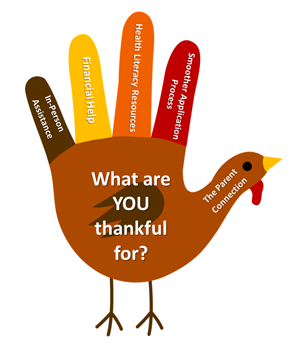As consumer health advocates across the country celebrated Thanksgiving this past week, we already had much to be thankful for. As we ate our turkey, stuffing and mashed potatoes, we were thankful not only for friends, family and good health, but also for the millions of Americans that have the opportunity to enroll in health insurance coverage during the second Affordable Care Act open enrollment period. Here are five of the things we on the Community Catalyst Children’s Health Team are thankful for during this open enrollment period:
1. In-person assistance: One of the tried and true ways of getting consumers covered is through in-person assistance, where consumers can walk through the application process and ask any  questions one on one with a trained expert. In the first open enrollment period, in-person assistance played a crucial role in connecting consumers to coverage; those who received in-person assistance were twice as likely to successfully enroll as those who attempted to do so without help. States and national groups have worked hard to spread the word that in-person assistance is available and connect consumers to enrollment specialists. For example, Colorado’s Blue Guide offers not only a searchable database of providers for uninsured and underinsured people, but also an option to search for nearby enrollment assistance. Maryland set up a 211 phone line so consumers would have a simple, easy-to-remember number to call with questions. At the national level, Enroll America produced their Get Covered Connector, a tool that allows consumers across America to find in-person assistance near them.
questions one on one with a trained expert. In the first open enrollment period, in-person assistance played a crucial role in connecting consumers to coverage; those who received in-person assistance were twice as likely to successfully enroll as those who attempted to do so without help. States and national groups have worked hard to spread the word that in-person assistance is available and connect consumers to enrollment specialists. For example, Colorado’s Blue Guide offers not only a searchable database of providers for uninsured and underinsured people, but also an option to search for nearby enrollment assistance. Maryland set up a 211 phone line so consumers would have a simple, easy-to-remember number to call with questions. At the national level, Enroll America produced their Get Covered Connector, a tool that allows consumers across America to find in-person assistance near them.
2. Financial help: Not only is there help available to get people enrolled, but there is financial assistance to help make coverage more affordable. The financial assistance—called subsidies—are available to folks making 100 percent to 400 percent of the Federal Poverty Level who buy insurance through the Marketplace. Emphasizing the availability of financial help to uninsured individuals has been shown to be a key factor in an individual deciding to sign up for coverage, especially when the messaging is accompanied by statistics, personal stories or cost comparisons. Consumers may use the Kaiser Family Foundation’s Marketplace Calculator to estimate how much assistance they may receive in assistance.
3. Health literacy resources: One lesson learned from the first open enrollment period was that health literacy, the extent to which people have the capacity to understand and access health information and services, was a significant barrier to enrolling in coverage for many Americans. Therefore, for during this open enrollment period, state and national groups have dedicated time and resources to developing outreach strategies and materials to improve health literacy and get people covered. For example, New Hampshire Voices for Health made a great checklist worksheet to walk consumers through what they should consider when choosing a health plan. Maine Health Access Foundation also came up with a booklet tool that clearly lays out what consumers need to consider and what they need to do to enroll in and use their insurance. We are thankful that during this open enrollment period consumers have more tools to understand their options and how to use them!
4. Smoother application process: This year, both HealthCare.gov and the state-based Marketplace are running much more smoothly than during the first open enrollment period, with thousands of consumers already enrolled in coverage. In addition, the HealthCare.gov application itself is now much easier to fill out, with a streamlined design and only 16 screens of questions to answer (compared to the 76 screens last year!), although this EZ application is only for some applicants. We are incredibly pleased that people are signing up for coverage with relative ease!
5. The parent connection: A successful open enrollment period – and each of the successes above – will be beneficial for kids. Not only because of the many options for subsidized family coverage, but because even just getting parents covered helps their kids. Voices for Virginia’s Children published this two-pager to highlight how covering parents (in this case through closing the coverage gap) improves child coverage and family health. Even outside of the immediate realm of health, insuring parents shields families from the financial burden of unexpected health care costs. Protecting parents’ emotional and financial resources allows them to better care for their children.
Of course, in the realm of consumer health, there is still work to be done and hurdles to overcome. This Thanksgiving, however, was a time to appreciate the tremendous strides that we have accomplished for consumers and especially for kids. What are you thankful for?
